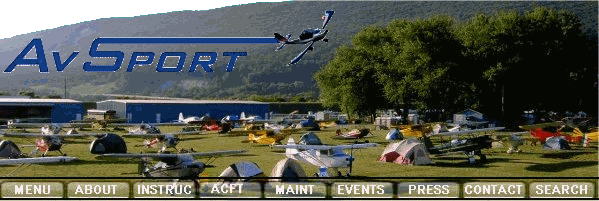
AvSport of Lock Haven -- 353 Proctor Street, Lock Haven PA 17745
Touch And Go
Excerpt from Winging It! With Dr. Paul: Forty Tales Your Flight Instructor Never Told You (copyright © 1989 by H. Paul Shuch)

Touch And Go
Excerpt from Winging It! With Dr. Paul: Forty Tales Your Flight Instructor Never Told You (copyright © 1989 by H. Paul Shuch)
I don't believe in the touch-and-go. The maneuver is favored by renter pilots paying Hobbs time for their wings, to maximize their pattern practice within a budgetary constraint. But every landing is different, each deserves calm reflection. The best lessons learned about landing an airplane are those you teach yourself during a leisurely taxi-back.
I don't believe in the touch-and-go. Tell me of the fuel wasted during taxi, and I'll reply that the cost of avgas is minuscule next to the repair bill, first time you reach to raise the flaps in haste and the gear comes up instead.
I don't believe in the touch-and-go, especially in a taildragger. The most critical part of a takeoff comes just as you lift the tail; the greatest challenge on landing comes during the rollout. Launch immediately after touchdown and you've missed practicing the most important part of both maneuvers. The FAA currency requirement for conventional landing gear reads three takeoffs and landings to a full stop in the past 90 days. Ever wonder why?
I don't believe in the touch-and-go. It's hard on the machinery. Consider a single circuit and bump: midfield downwind it's slow the airspeed down to within the white arc. Abeam the numbers, power back to the bottom of the green, carb heat on, a notch of flaps, trim for slow flight, fuel on proper tank, boost pump on, verify gear down and locked, mixture rich, prop in, seatbelts and shoulder harnesses on, check for hydraulic pressure, verify landing clearance. Turning base, visually clear the area, second notch of flaps, power back to idle, establish approach speed, trim wheel way back, GUMP check. Rolling out on final, verify airspeed one point three times stall, full flaps if high, leave 'em alone if low, one more gear check, verify on the VASI. Over the numbers, start the flare. Hold it off, track the centerline, steer with your feet, ailerons into the wind, touchdown attitude, runway contact. Now quick, flaps up, trim wheel forward, carb heat cold, check mixture rich, prop in, full throttle, right rudder to compensate for torque, accelerate and fly her off. Is that any way to treat an airplane?
I don't believe in the touch-and-go. Every landing, I tell my students, must always be to a full stop. Of course, for safety, every approach must always be considered a setup for a go-around. No landing is assured until the wheels are in the chocks. Often you may get to land, but always you're ready for the missed approach. And occasionally I might delay the go-around decision. Until the last possible moment. When the plane casts its shadow on the runway threshold. When the gear has greased the grass. When the ship has already started to slow down, its weight now transferred from wing to wheels. But I don't believe in . . .

If you can drive, you can fly!
Copyright © AvSport of Lock Haven, a subsidiary of Microcomm Consulting This page last updated 1 June 2010 |
Top of Page |